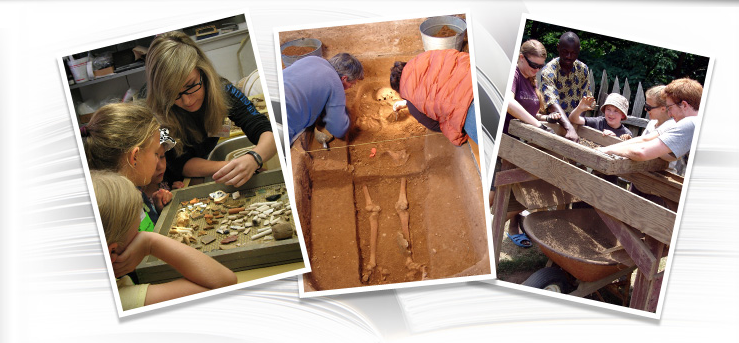2013 Week 2
After a grueling week of lectures – where we tried to stuff 400 years of ceramic identification into their brains – the students finally got out to begin excavation this week. We started with the units laid out at the end of last week.
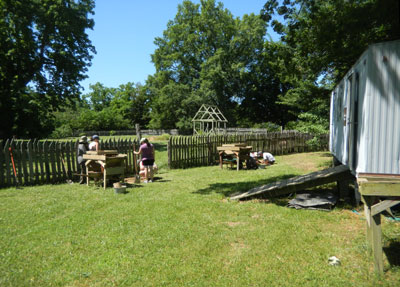
Excavation units north of the Calvert House fence.
These are located at the very northern edge of the site, 130 ft. from the house foundation and beyond the furthest fence. Excavation began in this area for two reasons. The first was to continue to look for fences that started at the corners of the house and ran northward. In previous years, we had traced these fences 100 ft. within the reconstructed fence but still do not know how far they might extend. Determining either that they extend this far or that they stop before they reach this area, will add to our understanding of the use of the site. The second reason for exploring this area was that it was only lightly tested by the earlier work. Large gaps exist between excavated units and our goal was to fill in some of those by our new work.
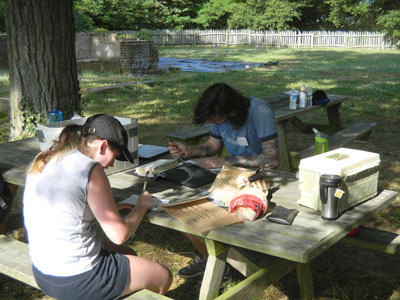
Record keeping is the archaeologist’s most important job.
While the students were all excited to be digging, they learned first-hand the proverb that I told them repeatedly last week: “The archaeologist’s most important job is record keeping.”
This is one of the important things that separates archaeologists from artifact collectors. We recognize that when we excavate a site, we destroy the context from which artifacts come. Once it is gone, we can never get it back. If we were only interested in artifacts, this would not matter. However, we seek to answer questions about how people used the site and how they lived. Further, we are concerned with assuring that the work we do now will be understandable and useful to researchers in the future. These goals can only be accomplished if we maintain a detailed record of what we did and what we found.
To be perfectly honest, I did not expect the students to find much in these first units. They are so far from the house that Colonial artifacts would be scarce and there was no other indication that we should find anything. I am happy to report that I was very wrong. There was a fair amount of 19th-century artifacts, including ceramics (e. g. transfer printed earthenware and slip-banded ware) and a clay marble. As the former location of the Brome-Howard house was relatively nearby, this was not surprising. There were also a significant number of 17th-century artifacts as well. Most of these were probably spill -over from a concentration around an outbuilding within the enclosed yard. Two pieces were puzzling however.
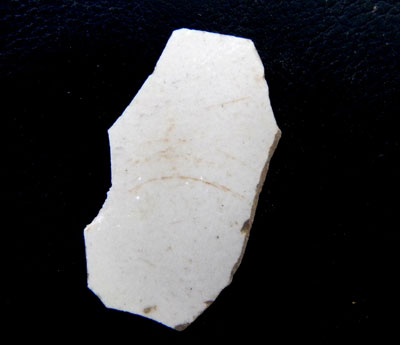
White salt-glazed stoneware fragment.
The photo shows one of two pieces of white salt-glazed stoneware. This represents a very finely potted, thin-walled vessel and has the distinctive pitted characteristic of salt-glazing. Ceramics such as this are English-made and date to the early 18th-century. And, there is the problem. This type of ceramic was being made well after the Calvert house was no longer occupied and long before the Brome-Howard house was built. Its presence on the site remains a mystery.
The biggest surprise from these units was the large number of Prehistoric period artifacts that have been found. In the small area we are excavating, we already have five projectile points.
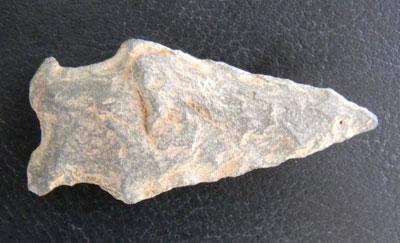
Otter creek point made of rhyolite.
I am not sure we recovered five projectile points in all of last summer’s excavations. The point in the photo is described as side-notched and archaeologists identify this as an Otter Creek point. This type of point dates to the Middle Archaic period, approximately 4850-3800 B. C., and is made of rhyolite, a fine-grained, volcanic rock. One of the other points was identified as a Bare Island point. This dates to the Late Archaic period, approximately 3200-2050 B. C., and is made of quartzite.
Another prehistoric artifact that caused quite a stir in the field was a ground stone celt.
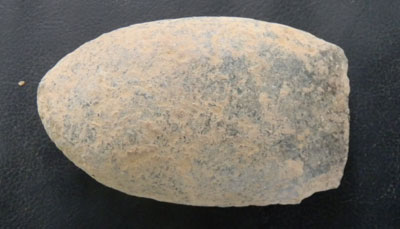
Ground stone celt.
One end of the artifact was patiently ground down, on both sides, to a sharp edge. This relatively rare type of artifact was used for chopping wood and/or splitting bone – performing the same function that an axe would. In my many years of excavating prehistoric sites, or sites with prehistoric components, I had never found one of these. It was a very exciting moment.
Of the four units begun this week, two are completed and one of those had no features at the subsoil level. The third had a couple of round, but undetermined features. No fence lines were evident. Next week, we will expand the area and continue to look for fences. Also, we will finish the unbackfilling of areas in the house and prepare for new excavations.


